Open-type researchers A02: Creation (the former period)
Ryota Iino
| Okazaki Institute for Integrative Bioscience, National Institutes of Natural Sciences Professor, Ph. D. |
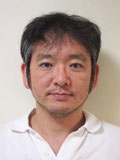 |
|
| Role: | A02 Open-type Researcher | |
|---|---|---|
| Title: | Creation of ATP-driven cyborg rotary molecular motors | |
| Purpose: | In this research project, we will create ATP-driven “cyborg” rotary molecular motors which have novel properties by substitution with unnatural amino acids or hybridization with other biological/artificial molecules. The examples are as follows. 1. An important amino acid residue for ATP hydrolysis of F1-ATPase, “arginine finger”, will be substituted to unnatural amino acid to create cyborg F1 motor which rotates faster than wild-type. 2. A cyborg F1 motor which rotates double-stranded DNA (dsDNA) as a rotor will be created. Although DNA helicases and translocases unwind and transport dsDNA, respectively, no molecular machines which rotate dsDNA exist. Furthermore, not only rotary motors but also cyborg linear molecular motors will be created. Single-molecule techniques will be applied to thoroughly assess the properties of created cyborg molecular motors. | |
Takafumi Ueno
| Graduate School of Bioscience and Biotechnology, Tokyo Institute of Technology Professor, Ph. D. |
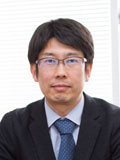 |
|
| Role: | A02 Open-type Researcher | |
|---|---|---|
| Title: | Construction of Protein needle to penetrate cell membrane | |
| Purpose: | In this research project, we will develop a protein needle constructed from the cell-puncturing device of the bacteriophage T4 for cell penetration. Crossing the barrier of cell membrane has been a challenge for the biomolecular transport process. Most of the synthetically designed cell penetrating materials incorporate positively charged grafts that endow cell permeability. On the contrary, natural molecular machines such as bacteriophage T4 employ a cell-puncturing needle consisting of a triple-stranded β-helical motif to puncture the cell membrane and inject DNA into the host cell during the initial step of the infection process. We have discovered that a recombinant protein needle consisting of an isolated triple-stranded β-helix motif of the bacteriophage T4 is able to spontaneously penetrate living cells. We will demonstrate that a distinct arrangement of the triple-stranded β-helical structure enables it to penetrate the cell primarily via a mechanism independent of endocytosis. We believe that this study represents an important scientific advance in deriving a new concept for the design of novel cell penetrating materials inspired by the natural functions of biosupramolecular machineries. | |
Yukiko Kamiya
| Institute of Materials and Systems for Sustainability Nagoya University Lecturer, Ph. D. |
 |
|
| Role: | A02 Open-type Researcher | |
|---|---|---|
| Title: | Construction of artificial system that perform cell-like motility governed by DNA-DNA interaction | |
| Purpose: | Various biological events are mostly governed by interactions of biological molecules such as oligosaccharide, protein, and DNA. On-and-off and assembly of the interactions generate macroscopic motions in biological systems. For example cell motility is driven by formation and deformation of actin filament. One of the approaches to learn how it works is design and building of an artificial system emulating the biological phenomenon. In this research project, we will rebuild a cell-like motility system driven by DNA-DNA interaction in which hybridization and dehybridization is controlled by light-dependent isomerization of photochromic compounds introduced into DNA. This will provide detail understanding of the principle mechanisms which produce the driving force for cell movements. Furthermore the achievements of this research will be an inspiration for novel design of biomolecular machines for new applications. | |
Kazuki Sada
| Department of Chemistry, Faculty of Science Hokkaido University Professor, Ph. D. |
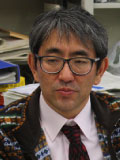 |
|
| Role: | A02 Open-type Researcher | |
|---|---|---|
| Title: | Artificial responsive systems sensitive to chemical reactions through dynamical ordering | |
| Purpose: | As an artificial model system for dynamical ordering of biomolecular systems, we focus on the formation of the molecular complexes between low-molecular-weight guest compounds (effectors) and macromolecular host compounds with respect to supramolecular chemistry. Our aim in this project is firstly establishment of rational molecular design for the thermal-responsive polymer systems that undergo drastic changes of the polymer conformation and solubility by thermal stimuli through the association and dissociation with the effectors. As the second aim, we will attempt the conjugation between the phase separations of the host polymers and chemical reactions of the effectors via controlling the solubility of the polymers by the change of the concentration of the effectors. As the goal of this project, we will try to create the polymer catalysts whose relativities are controlled by another chemical reactions by incorporation of catalytic sites into the thermal-responsive polymer systems. This should provide us important insights for allosteric systems that govern the concentrations of chemicals in biological systems. | |
Tomohisa Sawada
| Department of Applied Chemistry, Graduate School of Engineering The University of Tokyo Assistant Professor, Ph. D. |
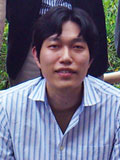 |
|
| Role: | A02 Open-type Researcher | |
|---|---|---|
| Title: | Creation of hybrid dynamic ordering systems based on supramolecular complexes and peptide folding | |
| Purpose: | In this research project, we will create hybrid materials of artificial molecules and biomolecules for examination of intrinsic dynamic ordering behaviors of biomolecules. We attempt the construction of new nano-materials through utilization of intrinsic dynamic ordering abilities of peptides and also supramolecular coordination techniques. We especially focus on oligopeptides folding and assembly behaviors among various biomolecular dynamic ordering in this project. Through peptide folding and assembly events on supramolecular scaffolds, precise nanocavities surrounded by folded peptides can be developed. The obtained artificial nanocavities will be applicable for observation of encapsulated biomolecules’ interactions. The new materials of this project will lead new trend in the integrated field of biomolecules and artificial systems. | |
Kazunori Sugiyasu
| National Institute for Materials Science, Polymer Materials Unit, Organic Materials Group Senior Researcher, Ph. D. |
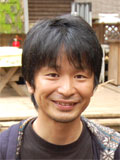 |
|
| Role: | A02 Open-type Researcher | |
|---|---|---|
| Title: | Infectious Supramolecular Assemblies: Unveiling the Mechanism and Controlling its Time Evolution through a Molecular Approach | |
| Purpose: | We have recently found a very interesting phenomenon in supramolecular assemblies: “infection” between supramolecular assemblies that resembles prion infection process. This research project aims at elucidating the mechanism of this unique phenomenon based on thermodynamic and kinetic insights, while especially focusing on the molecular structures. Using this understanding of the mechanism, in the end, we would like to program the time-evolution of the “supramolecular infection”. We expect that this study will lead to autonomous materials that function as the occasion demands, much like biological systems. | |
Daisuke Suzuki
| Graduate School of Textile Science & Technology, Shinshu University Associate Professor, Ph. D. |
 |
|
| Role: | A02 Open-type Researcher | |
|---|---|---|
| Title: | Dynamic ordering of polymer colloid by using functional hydrogel particles | |
| Purpose: | In this project, we will create novel stimuli-responsive polymer particles whose physico/chemical properties can be changed autonomously and periodically. Using the polymer particles as building blocks, higher dimensional ordered structures will be constructed. In particular, by precisely controlling the structure of the constituent polymer particles, highly ordered particle assemblies will be obtained. The study of the artificial system of polymer particles will help us to understand the dynamic ordering of biomolecular systems. | |
Eugene Futai
| Department of Molecular and Cell Biology, Graduate School of Agricultural Science, Tohoku University, Associate Professor, Ph. D. |
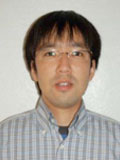 |
|
| Role: | A02 Open-type Researcher | |
|---|---|---|
| Title: | Exploration of dynamic coat in coated-vesicle formation | |
| Purpose: | COPII-coated vesicles forms at the endoplasmic reticulum for cargo transport to the Golgi apparatus. We will use in vitro reconstitution to examine the roles of the COPII coat in the vesicle formation. The generation of vesicles from synthetic liposome membranes requires the COPII coat components Sar1, Sec23/24 dimer, Sec13/31 tetramer and nonhydrolyzable GTP analog, such as GMP-PNP. However, in the presence of GTP, nucleotide hydrolysis by Sar1p renders the coat insufficiently stable to sustain vesicle budding. In order to recapitulate a more authentic, GTP-dependent budding, we have introduced additional factors and evaluated the dynamics of coat assembly and disassembly by real-time assays. So far, we found that Sec12 nucleotide exchange catalyst activates Sar1 and promotes the bud formation. However, it turned out that such reaction do not progress efficiently through the vesicle fission. In this research project, we will further develop the in vitro reconstitution and elucidate molecular mechanisms of the vesicle budding, the cargo enrichment, and the vesicle fission with the dynamic coat. | |
Shiroh Futaki
| Institute for Chemical Research Kyoto University Professor, Ph. D. |
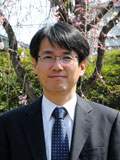 |
|
| Role: | A02 Open-type Researcher | |
|---|---|---|
| Title: | Peptide tools that induce curvatures and structural alterations in biomembranes | |
| Purpose: | It has been known that membrane remodeling such as fission, fusion, protrusion and vesiculation, plays a critical role in cellular life, including membrane trafficking, movement, growth and division. The elucidation of proteins that can induce membrane curvature has highlighted their importance in the regulation of membrane remodeling. The ultimate goal of this study is to develop peptide tools that effectively induce/control structural alterations or curvatures in biomembranes. For this purpose, we will investigate the methods of curvature induction using a series of designed peptides to understand the basic requisites for curvature induction. We will also analyze the physicochemical properties of the peptides that are important for the curvature induction, and study their modes of interaction with membranes to facilitate the curvature formation. | |
Tomoaki Matsuura
| Department of Biotechnology, Graduate School of Engineering, Osaka University Associate Professor, Ph. D. |
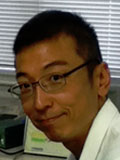 |
|
| Role: | A02 Open-type Researcher | |
|---|---|---|
| Title: | Reconstituting the membrane dynamics using in-liposome membrane protein synthesis | |
| Purpose: | Membrane dynamics of the mitochondria has been investigated and the molecules involved have been identified. The approach used for the identification is a ”top-down approach” that is to investigate the phenotypic changes of a living cell upon the knockdown or knockout of a particular gene. On the other hand, bottom-up approach has rarely been used, presumably due to the difficulty in working with membrane proteins that are the major identified components. In the current study, we will synthesize Letm1, one of the mitochondria inner membrane proteins, using a reconstituted in vitro transcription-translation system inside a cell-size liposome, and investigate its effect on the membrane dynamics. This bottom-up approach is expected to clarify the role of the membrane protein on the dynamics of the cellular membrane. | |
Hiroyuki Miyake
| Department of Chemistry, Graduate School of Science, Osaka City University Associate Professor, Ph. D. |
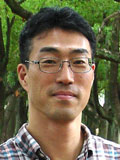 |
|
| Role: | A02 Open-type Researcher | |
|---|---|---|
| Title: | Creation of multi-dynamic ordering systems and their time-programming based on molecular recognition chemistry of metallopeptides | |
| Purpose: | Since metal coordination chemistry has some attractive features including characteristic stereochemistries and dynamic ligand exchanges, their dynamic systems have potential to program both of space and time evolutions which develop artificial multi-dynamic ordering systems in response to the external stimuli as observed in biological systems. In this research project, we attempt to create novel multi-dynamic ordering systems based on the dynamic structural conversions of the helical metallopeptides constructed from chiral bis(amino acid) ligand and labile metal cation, in which successive structural conversions could be achieved via combination of external stimuli offering weak molecular interactions (acid, base, anion, oxidant, reductant and light and selective molecular recognition) in supramolecular level. We will further develop the time-programming of their autonomous transformation of the metallopeptides for the development of integrated functions. | |
